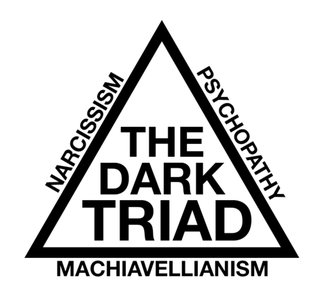Self-Esteem
Why Contemptuous People Have Fragile Self-Esteem
The vulnerable dark triad helps explain nasty people's hypersensitivity.
Posted June 26, 2019

In their investigation of the contemptuous personality, social psychologist Roberta A. Schriber and colleagues found that contempt-proneness, despite involving a tendency to look down on others, is associated with fragile self-esteem.
Although surprising at first, the link between dispositional contempt and fragile self-esteem can be explained by the connection between contempt-proneness and vulnerable narcissism. Psychologists Jessica Tracy and Richard Robins point to Willy Loman, the tragic protagonist in Arthur Miller's 1949 play Death of a Salesman, as a paradigmatic example of a person with fragile self-esteem. Loman’s sense of self is split between a positive self-image, which is consciously present to him most of the time, and a mostly unconscious negative self-image. According to the positive idealized self-image, he is a successful salesman, who has raised two talented sons. According to the negative self-image, he has failed as a businessman and a father.
Although mostly hidden from conscious awareness, Loman’s negative self-image easily resurfaces. To avoid having to face the self-doubt, Loman develops defense mechanisms that can help keep it buried: He presents himself to others in a deceptively positive light; he adjusts his memories to ensure they paint a picture of him and his sons as successful, and he makes up excuses when necessary to explain failures. But despite these efforts, his negative views of himself make their way into his conscious mind every so often, causing his positive self-image to crackle. Loman’s actual feeling of self-worth is thus highly unstable, ranging from excessive pride and arrogance to pathetic self-pity.
In scenes in which he feels good about himself, Loman is a quintessential contemptuous person, exploitative, harboring excessive pride of his imagined accomplishments and feeling entitled to special treatment. For example, he is unshakeable in his conviction that his boss will offer him a new position that doesn’t require traveling, despite having failed in his current job as a salesman.
As Tracy and Robins point out, Loman is a vulnerable narcissist. Vulnerable narcissism is one of the antagonistic personalities in the so-called vulnerable dark triad, which psychologist Joshua D. Miller and his colleagues called attention to in their 2009 article “Searching for a Vulnerable Dark Triad.”
The vulnerable dark triad should be kept distinct from the personality construct social psychologists Delroy Paulhus and Kevin Williams called "the dark triad" in their seminal paper “The Dark Triad of Personality.” The dark triad refers to the constellation of narcissism, psychopathy, and Machiavellianism, which are all tendencies towards malevolent behavior that can be found in the normal (or subclinical) population. (Sadism was subsequently included as a fourth trait in the so-called dark tetrad.)
There is considerable overlap among the dark personalities. To varying degrees, they all imply an evil or malevolent character with trait-like tendencies toward self-promotion, duplicity, callous exploitation, emotional coldness, contempt, hatred, and aggression. But despite their overlap, the dark personalities are distinct personality constructs that each have their own core traits.
The vulnerable dark triad refers to the constellation of vulnerable narcissism, borderline personality, and secondary psychopathy. In their study, Miller and his collaborators found that the vulnerable dark traits were linked to high neuroticism and low extraversion, low conscientiousness, and low agreeableness, where low agreeableness was manifested in “self-centered, dishonest, and callous attitudes toward others” (p. 1556).
Although the borderline trait is genetically linked to antisocial personality disorder — the clinical variant of secondary psychopathy — the researchers found that the vulnerable dark traits that were most closely related on the Big-Five model of personality were borderline personality and vulnerable narcissism.
Despite their similar Big-Five profiles, there are important differences in the underlying deficits of vulnerable narcissism and the borderline personality. Whereas the vulnerable narcissist’s explicit self-image is vulnerable but positive overall, borderlines oscillate between feeling that they lack a core sense of identity and seeing themselves in an extremely negative light.
The reason that contemptuous people have fragile self-esteem is that they tend to have many of the core vulnerable narcissistic traits. Despite their contempt-proneness, they are hypersensitive to criticism and prone to overreact emotionally, always on the verge of bursting open with anger.
References
Miller, J. D., Dir, A., Gentile, B., Wilson, L., Pryor, L. R., & Campbell, W. K. (2009). “Searching for a Vulnerable Dark Triad: Comparing Factor 2 Psychopathy, Vulnerable Narcissism, and Borderline Personality Disorder,” Journal of Personality, 78: 1529–1564.
Paulhus, Delroy L; Williams, Kevin M (2002). “The Dark Triad of Personality: Narcissism, Machiavellianism, and Psychopathy,” Journal of Research in Personality 36 (6): 556–563.
Schriber, RA.; Chung, JM.; Sorensen, KS.; Robins, RW. (2017). “Dispositional Contempt: A First Look at the Contemptuous Person,” Journal of Personality and Social Psychology, 113(2): 280-309.
Tracy, J. L., & Robins, R. W. (2003). “ ‘Death of a (Narcissistic) Salesman’: An Integrative Model of Fragile Self-Esteem,” Psychological Inquiry, 14: 57-62.




